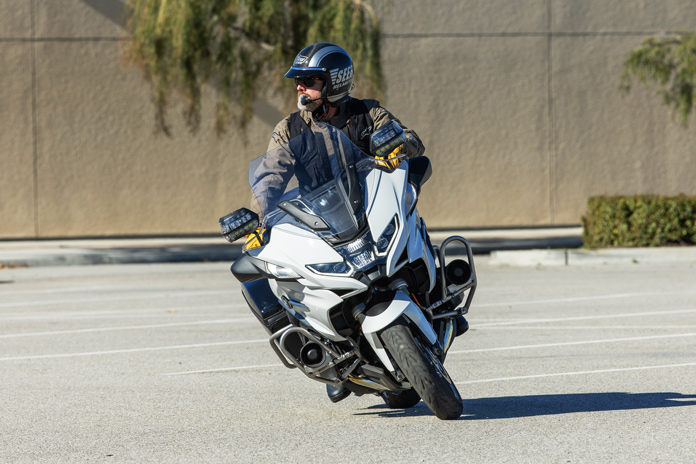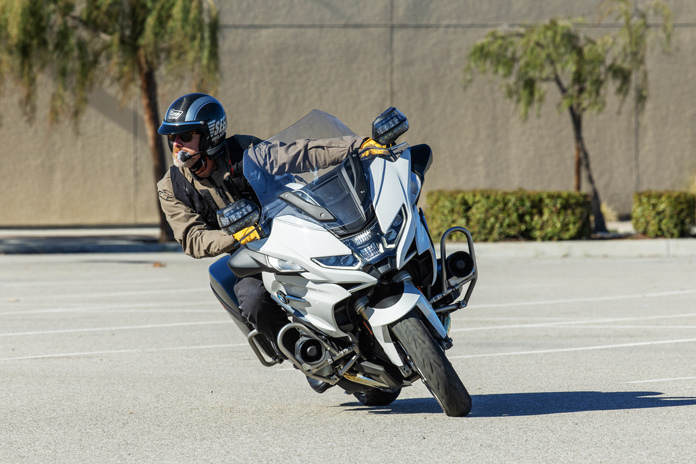
I think it’s fair to say there are a few subjects we should all steer clear of if we want to foster a harmonious relationship with other humans. Politics and religion are obvious land mines. And my wife knows that recommending a culling of the herd in the garage isn’t a party‑starter. But it appears I’ve discovered a ripe one you might also have some feelings about. And knowing how domineering and strong‑willed you are, when the dust settles, I really hope we can still be friends. Okay, here goes nothing.
There exists a feverish debate amongst motorcyclists regarding two uniquely different approaches to riding. Of course, there are more than two, but these revolve around the rider’s center of balance (center line) in relation to the motorcycle’s center of balance while navigating turns. Yep, a global hot button, this one. But please don’t ask for the Gold Codes just yet.
When a motorcycle starts to lean over and fall into a turn, its center of gravity shifts inward, causing it to head toward the ground (just go with me here; it’s science). When this happens, we have a couple options. One, we can counterbalance, a technique that shifts our center of gravity to the outside of the bike’s center of gravity, effectively countering the effects of the motorcycle’s weight transfer as it falls in. Two, we can lean our body into the curve, shifting our center of gravity to the inside of the motorcycle’s center of gravity as it falls in, effectivelytrading the motorcycle’s weight with our own as the bike leans over. This on‑road technique applies to paved corners with a good surface.
Hmmm, what to do. Flip a coin? Call a friend? Ask “what would Fonzie do?” Solid options, no doubt.
But before we rush over to Arnold’s and pull Fonzie away from the Polaski twins, I’ll kick off the group share and give you my two cents on the topic. When I do police motor competitions on my BMW R 1250 RT‑P, I employ as many tricks as my tiny brain can remember to execute tight maneuvers in confined spaces. These events are 1st‑gear scenarios, and the speeds drop as low as 5 mph, triggering the bike’s mass to fall like a 650‑lb paperweight. In other words, the bike’s weight is compounded by the fact that the gyroscopic forces and inertia are greatly reduced at slower speeds, while nature’s gravity amp is cranked up to 11. Deep science, yes, but an important thing to keep in mind because it’s a major contributing factor for why we throw our feet down, break into a cold sweat, or abandon ship altogether when speed slows down and our bike leans over.
These days I do my best to mitigate unplanned and unsettling weight shifts, so I rely on counterbalancing when I slow to walking speeds. By offsetting the bike’s lean‑in mass with counterbalancing, my big Beemer falls over slower, falls over farther, and turns a much tighter radius. All big wins. Yes, clutch control and throttle input are players in my process, but counterbalancing does most of the heavy lifting.
Sounds like we solved the riddle then, and we should counterbalance the bike whenever it leans over? Absolutely, yes. Well, unless your motorcycle has more gears in the transmission than 1st. Let me explain why and how my strategy changes when I click through the gears.
As an Advanced Riding Clinic instructor for Total Control, I co‑teach clinics where we take students on‑track and put them through advanced concepts and techniques to help manage speed situations on the street. A major challenge we face as riders (and help mitigate as instructors) are speed situations in corners. You know that as speed increases, your motorcycle requires a greater lean angle for whatever radius you are navigating. This can be problematic if you don’t have techniques and a plan to deal with it.

Let’s imagine Future You: It’s a magical Monday, and you’re having a “personal medical issue,” so work is a no‑go. Precisely 27 minutes later, you are fully kitted up, and that pesky walking pneumonia has miraculously vanished as you drop into a long right‑hander. At that precise moment, ABBA’s “Dancing Queen” pours into your helmet speakers, and because this is your jam, mid‑corner speeds unwittingly climb. Suddenly, and without warning, your bike begins shedding unwanted poundage by grinding hard parts along the pavement as your line widens and pushes you toward the double yellows. Not great.
Future You will do one of three things here: 1) Panic and grab the brakes mid‑corner, causing abrupt weight transfer that will stand your bike up and aim it toward the portion of the roadway you are trying to avoid; 2) Eventually drag parts so much that you lever the tires off the ground and initiate a low‑side crash; or 3) Move your body’s center line to the inside of the motorcycle’s center line (leaning in), effectively trading the bike’s mass for your mass, causing the bike to reduce its lean angle, tighten its line, and maintain its speed. Leaning in doesn’t necessitate high speeds or excessive hanging off, but rather positioning oneself toward the inside of the curve for cornering. Let’s go with option 3 on this one.
Let me land the plane here. When you find yourself in 1st‑gear situations, it’s all about counterbalancing, but as soon as the speeds pick up and you click 2nd gear and beyond, shift your body’s center line to the inside of the motorcycle’s center line. If you want a live‑action example, go to my YouTube channel (Police Motor Training with Quinn Redeker) and find the video titled: “Motorcycle Technique: Counterbalance vs Lean (Road Race Style).” It provides a clear visual demonstration and explanation as to why and where I use one style over the other.
Fantastic. You’ve said nothing this whole time, so either we are in total agreement on this or I’ve offended you somewhere along the way. In either case, maybe this will build a bridge of sorts:
“We seldom learn much from someone with whom we agree.” – Mokokoma Mokhonoana
Find Quinn at Police Motor Training.
See all Motor School with Quinn Redeker articles here.
The post Motor School with Quinn Redeker: Which Way Do You Lean? appeared first on Rider Magazine.
Source: RiderMagazine.com
